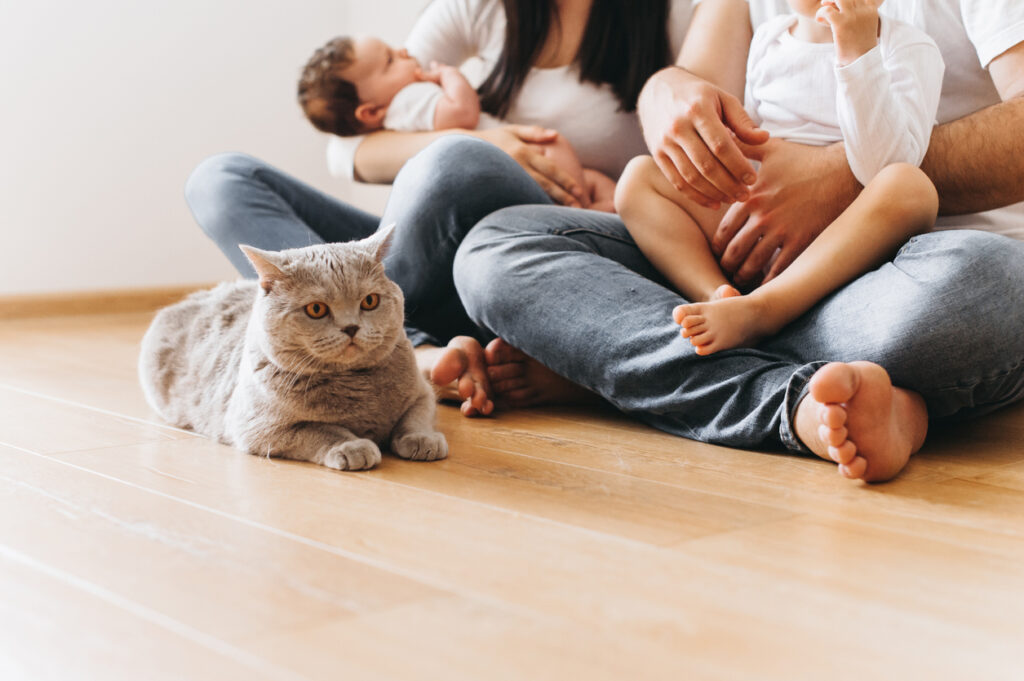Massachusetts and New England are currently going through a heat wave, which means it's important…

How to Get Your Pet Ready For a New Baby
Spring is here, which means all kinds of new life! From new plants, flowers, and buds, to baby animals being born, and new babies being born into families. This is an exciting time for families, but can be a cause of stress to your pets. In this time of excitement, it is crucial to remember your furry friends and help them adjust as smoothly as possible to a new household dynamic. Preparing your pet well in advance is key to a smooth and safe transition for everyone
Before Bringing the Baby Home: Lay the Groundwork
1. Health Check-Up and Basic Needs
- Visit the Vet: Schedule a wellness exam to ensure your pet is healthy, up-to-date on vaccinations, and free of parasites like fleas, ticks, or worms. Some parasite treatments can be toxic to children, so discuss options with our experts at East Springfield Veterinary Hospital. Address any underlying pain issues (like arthritis or sore spots) that could cause reactivity if touched unexpectedly.
- Spay/Neuter: If your pet isn’t already spayed or neutered, consider doing so now, as it can sometimes help reduce aggression or behavioral issues.
- Know Your Species: Ensure you understand the specific needs (diet, habitat, exercise) of your pet’s species.
2. Gradually Adjust Your Routine
- Shift Schedules: Your schedule will change. Start gradually adjusting feeding times, walk lengths/times, and play sessions now to reflect the likely post-baby routine. This helps prevent the pet associating negative changes directly with the baby.
- Modify Attention: Your pet might be used to constant, perhaps unconscious, attention (like petting as you walk by). Gradually decrease this “absent-minded” attention while increasing dedicated, quality one-on-one time (like a focused play session).
- Change Caregivers: If you’ll be the primary baby caregiver, have your partner or another family member start taking over some pet duties now (feeding, walks).
3. Practice Desensitizing to Baby Stimuli
- Sounds: Play recordings of baby sounds like crying, cooing, and toy noises daily. Start at a very low volume and gradually increase it only if your pet remains calm, rewarding them with praise or treats.
- Smells: Introduce your pet to baby smells by wearing baby lotion or powder. Let them sniff new baby items. After the birth, have someone bring home an item the baby has worn (like a hat or blanket – after the baby’s first bath, not immediately after birth) for your pet to investigate calmly.
- Sights & Equipment: Set up nursery furniture and baby gear like swings, and strollers early, letting your pet investigate before they become off-limits. Use a realistic baby doll to practice carrying, holding, and interacting with the “baby” while rewarding your pet’s calm behavior.
4. Establish Boundaries and Reinforce Training
- Set Rules Now: Decide which areas or furniture will be off-limits after the baby arrives, and start enforcing these rules immediately. Use baby gates if needed, installing them early so the pet doesn’t feel suddenly restricted. For cats, consider sticky tape on surfaces like cribs or changing tables to discourage jumping up. Ask yourself questions such as: Will my pet be allowed in the nursery? Will their sleeping arrangements change?
- Brush Up Obedience: Reinforce basic commands like “sit,” “stay,” “down,” “come,” and “go to your mat/bed”. Practice these consistently.
- Curb Jumping: If your pet jumps up on people, train them to stop now. You don’t want them jumping when you’re holding the baby.
5. Create Safe Spaces
- Ensure your pet has a comfortable, safe space (like a crate, bed, room, or high perch for cats) where they can retreat and feel secure, undisturbed by the baby. Make this space pleasant with toys or treats.
6. Manage the Environment
- Relocate Gradually: If you need to move food bowls, litter boxes, or pet beds/cages, do it slowly – moving things just a foot or so each day towards the new location. Sudden changes can cause stress or accidents. Keep litter boxes clean (scoop daily) and away from noisy appliances. Pregnant individuals should avoid cleaning cat litter boxes due to the risk of toxoplasmosis.
- Exercise: Ensure your pet continues to get adequate physical and mental exercise. Bored or frustrated pets are more likely to develop behavioral issues. Interactive toys can help. Consider hiring a dog walker if needed.
The Big Day: Introducing Your Pet
- Burn Off Energy: Have a helper exercise your dog or play with your cat before you arrive home with the baby.
- Greet Pet First: When you arrive, greet your pet alone first, without the baby. They’ll have missed you and will be interested in your new smells.
- Controlled Introduction: Bring the baby in calmly, and keep dogs on a leash initially. Allow your pet to sniff the baby gently from a distance, rewarding calm behavior with treats and praise. Keep initial interactions short and positive, and don’t force the interaction.

Life After Baby Arrives: Maintaining Harmony
- SUPERVISION IS KEY: Never, ever leave your baby or small child unsupervised with any pet, regardless of the pet’s size or temperament. Accidents can happen in seconds.
- Maintain Routines: As much as possible, stick to your pet’s established feeding, walking, and playtime schedules.
- Positive Reinforcement: Reward your pet with treats, praise, and attention when they are calm and behaving well around the baby. Help them associate the baby with good things.
- Respect Pet’s Space: Ensure your pet can always retreat to their safe space when needed. Teach your child to respect the pet’s space, especially when the pet is eating, sleeping, or chewing a toy.
- Teach Gentle Interactions: As your child grows, teach them how to interact gently and appropriately with the pet. Supervise closely.
- Recognize Stress: Learn your pet’s body language. If they seem stressed (panting, lip licking, yawning, avoiding eye contact, tail tucked), give them space and ensure the baby isn’t near them. Identify and manage triggers.
- Hygiene: Practice good hygiene, especially regarding litter boxes and pet waste, to minimize potential health risks.
Preparing your pet for a new baby takes time and patience, but investing the effort beforehand can lead to a peaceful coexistence and a wonderful bond between your child and furry companion. If you encounter significant behavioral issues or aggression, consult your veterinarian or a professional animal behaviorist for help.
Sources:



